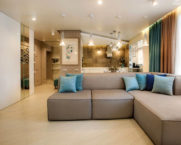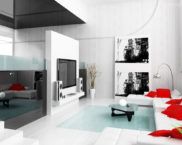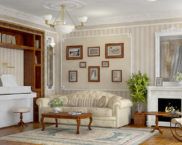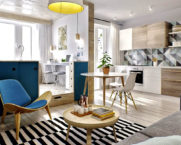How to properly hang a modular picture on the wall: options for fasteners and how to use them
More recently, the main requirement for the design of your own house or apartment was limited only to correctly selected wallpaper: color, pattern, texture. Today, designer accessories have entered our lives as an integral part of the interior of living quarters. One of them that have become very popular today are modular paintings. In this article we will talk specifically about them and how to properly hang a modular picture on the wall using different technologies.
The content of the article
What is a modular picture
This is a composition consisting of several elements, which depict a part of a drawing or a fragment of one common canvas. When the parts are joined, a general plan is formed, therefore it is very important to correctly arrange the modules, comparing them with each other.
The number of modules must be at least two. By the number of elements, modular paintings are called differently:
- a picture consisting of two elements is called diptych;
- from three parts - triptych;
- out of five - penaptych;
- more than five elements - polyptych.
Moreover, a large number does not always mean a larger picture size. Elements can be of small width, which makes it possible to more efficiently display a piece of the general picture on them by writing small details on it.
This concludes the conversation about the modular paintings themselves and go directly to the main topic of the article - how to hang modular paintings on the wall.
Options for how to hang paintings on the wall
Let's start with the fact that modular elements are pieces of one large canvas.They are a purely constructively separate picture that can be hung in any convenient way. The main requirement is the strength of the fasteners, which would support the weight of the item being hung. The second requirement is the exact location of the modules among themselves and in the required plane. For example, in the photo below you can see that the parts of one whole are not on the same level. So this is the dimensional location on the wall and must be accurately determined.
It is not easy to do this right away. Anyone who is faced with the task of attaching paintings to the wall with their own hands for the first time should understand that the modular version differs from the usual one precisely in that it is not one painting, but several that should be assembled on the wall surface in a certain order. The easiest option is if the modules are located either horizontally or vertically. In this case, you just need to put all the parts on the same line, even if they have different sizes.
In all other respects, this is the usual hanging of framed photographs or paintings. But there is one more nuance, determined by the title of the next section.
Distance between modular paintings
In this regard, there are no strict standards, no one has ever defined them. It is just that visually large gaps between the modules reduce the visibility of the integral canvas. Therefore, the shorter the distance, the better. Although experts note that it is also not worth installing parts end-to-end to each other, it will be difficult to mount to the wall. Therefore, the optimal parameter is 2-4 cm.

How to correctly position the modules of the picture on the wall, indicating the distance between the elements
Therefore, there is such a recommendation - before attaching a modular-type picture to the wall, you need to lay out its parts on the floor near the wall in the order that they will be installed one by one. In this case, it is necessary to accurately lay them out relative to each other, so that there is a single canvas of one horizon. Then, the installation is based on the lower or upper edge of the largest part. And already from it the markings of all elements are carried.
The photo below shows the layout of the modules on the floor. It is in this order and in this arrangement that they should be on the wall.
Please note that the photo shows a composition of five elements, as one of the most commonly used. Therefore, the question of how to hang a modular picture of 5 parts is quite common. It should be noted that such an arrangement of elements relative to each other is not the most difficult, because they are practically on the same line. Some of them are just shifted up or down relative to the main horizontal. Therefore, the installation is based on the middle element, its canvas is the main one in terms of uniform arrangement relative to the axis of the whole picture. It is he who must be hung first. The rest take turns to the left or right side.
Now it is clear how to start the hanging process. We turn to the main topic of the article - how to properly hang modular paintings on the wall, or rather, to the mounting methods.
How to attach modular paintings to the wall
There are many ways to ensure that the paintings do not fall and hang on the wall surface for a long time. Let's consider some of them as the simplest and most reliable.
Fasteners for modular paintings
Let's designate all the fasteners at once, and then consider how you can use them to fix the modular picture on the wall:
- An ordinary self-tapping screw screwed into the wall with a dowel.
- Nail if the wall is wooden.
- Liquid Nails.
- Double sided tape.
- Velcro.
- Spider hook.
- Smart retainer.
There is no point in considering the first two, these are ordinary fasteners that have been used for a long time. They can be classified as classic fasteners. But with others you need to figure it out thoroughly.
Liquid Nails
This adhesive is known to be strong and reliable. But when using it, care must be taken to ensure that the wall surface is very even. The thing is that the rest of the fasteners can smooth out some irregularities in the plane. The adhesive composition is applied in a thin layer, besides, the paintings are pressed tightly against the wall. This means that surface irregularities will immediately be transmitted to the suspended modules in the form of distortions, which will be visible to the naked eye.
As for the process itself, depending on the size and weight of the picture, liquid nails are applied either to the entire perimeter of the frame from the back side, or in sections.
Then it is applied to the wall along the marked area and pressed with hands. Within a few minutes, the element can be moved to level. It should be noted that in this way it is possible to install pictures in any premises for their intended purpose, because the adhesive composition does not change its strength properties either under the influence of temperature changes or with changes in humidity. So the pictures in the kitchen or in the bathroom, glued with liquid nails, hang for more than one year.
Double sided tape
This fastening material has appeared on the market relatively recently, but many home craftsmen have rightfully appreciated it as one of the most reliable and easy to use. In principle, this is a fabric base, treated with an adhesive on both sides. Above, the adhesive tape is closed on both sides with a protective polymer film. Remove the last one, apply the strip to the required place, and it is immediately firmly attached to it.
It is on this quality of adhesive tape that the method of its use for hanging modular paintings is based. How it's done:
- The sticky material is cut into several lengths up to 10 cm.
- A protective film is removed from one side.
- The adhesive tape is pressed against the picture frame with the adhesive side.
- This is how all segments are established, evenly spaced from each other. Be sure to install at the corners of the object.
- The upper protective films are removed.
- The module is pressed in place of its installation.

Velcro
These fasteners are called the "Command" system. By their use, they resemble double-sided tape, but these are only two parts, each of which has one side is a sticky adhesive composition, and the opposite is Velcro. That is, one of them is attached to the wall, the second to the painting. Then the latter is applied to the wall so that both parts of the Velcro dock with each other.
The most unique thing about this whole version is that the Velcro is also easily separated from each other. Of course, in the connected state, they firmly hold the picture on the wall. But not too much effort allows you to separate them. So, so to speak, these are reusable fasteners. We add that you can install ordinary plastic hooks on the Velcro, which come with the fasteners, and the modules are already hung on them. Also a simple option with the ability to shoot a picture.
There is exactly the same mounting system, which is called "Kreps".You can see how it should be used in the video below.
Spiderman picture hook
This fastener got its name from the resemblance to a spider. This is a plastic hook with two to four studs sticking out like insect legs. The nails are made of strong steel and have sharp ends, so they can be hammered into almost any building material with a hammer. The main requirement for the latter is strength in the sense that it does not crumble under the influence of shock loads.

Spider hooks are of different sizes, the larger it is, the greater the bearing capacity of the fastener
The use of spider hooks is simple:
- Pull the studs towards the front of the fastener.
- They put it at the place of installation.
- Hammer the legs to the plane of the hook.
- If it is necessary to remove a fastener, it is simply pulled out of the wall with pliers. There will be 2-4 small holes on the surface, which are easy to mask.
Smart lock
These are polyurethane rectangles that can be easily attached to any surface. These are reusable products that, after dismantling, just need to be rinsed with warm water, and they are ready for use again.
For you to understand what we are talking about, we suggest watching the video below.
Video: how you can hang modular paintings and other household items on the wall
What else can you hang a modular picture on?
Another rather interesting option is a hanging system for paintings and photographs. In fact, this is a rail (wooden, metal or plastic) that is attached to the wall from the ceiling. Vertical rods are fixed on it, to which the picture modules themselves must be attached. In this case, the parts can be moved along the rods, lowering or raising.
Threads with hooks at the ends can be used as guides. This is a more complex structure, because it has a built-in mechanism by which the elements of the modular canvas are lowered and raised.
How much and where can you buy mounts for modular paintings
Today, all the fasteners described above are not in short supply. They are sold by ordinary construction stores and online services. Let's just designate their average prices across the country.
| Name | Spider hook | Command | Double sided tape | Liquid Nails |
|---|---|---|---|---|
| price, rub. | 600 - per piece | 300 - per set | 35-350 (depending on tape width) | 200 - per tube |
How to hang a painting on a concrete wall
The last question of the article concerns the most common wall, or rather, the material from which it is made. Concrete is the most durable material of all wall materials. Previously, in order to hang a picture, you had to drill it, drive in dowels or wooden "chopiks", and only then screw the screws into them. It is reliable in terms of withstanding heavy loads, but it is long and dusty, and the process itself cannot be called simple.
Therefore, all the fasteners described above can be used for concrete walls. The main thing for the former is a clean and level surface.
So, we have analyzed in this article the question of how to hang a modular picture, regardless of whether it includes five segments, two or ten. If you have any questions, leave them in the comments. Our editors will definitely answer them.



































